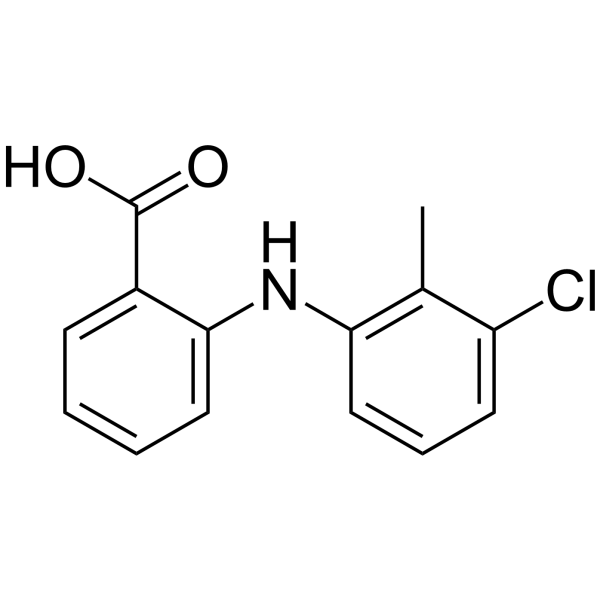上海金畔生物科技有限公司为生命科学和医药研发人员提供生物活性分子抑制剂、激动剂、特异性抑制剂、化合物库、重组蛋白,专注于信号通路和疾病研究领域。
Tolfenamic Acid (Synonyms: 托芬那酸; GEA 6414) 纯度: 99.56%
Tolfenamic Acid (GEA 6414) 是一种非甾体抗炎剂和抗癌剂,能够选择性地抑制 COX-2 的活性,在 LPS 诱导的犬 DH82 单核细胞/巨噬细胞中,对 COX-2 的 IC50 值为 13.49 μM (3.53 μg/mL),对 COX-1 无作用。

Tolfenamic Acid Chemical Structure
CAS No. : 13710-19-5
| 规格 | 价格 | 是否有货 | 数量 |
|---|---|---|---|
| Free Sample (0.1-0.5 mg) | Apply now | ||
| 10 mM * 1 mL in DMSO | ¥500 | In-stock | |
| 500 mg | ¥400 | In-stock | |
| 1 g | ¥500 | In-stock | |
| 10 g | ¥1500 | In-stock | |
| 50 g | 询价 |
* Please select Quantity before adding items.
Tolfenamic Acid 相关产品
•相关化合物库:
- Drug Repurposing Compound Library Plus
- FDA-Approved Drug Library Plus
- FDA-Approved Drug Library Mini
- Bioactive Compound Library Plus
- Immunology/Inflammation Compound Library
- FDA-Approved Drug Library
- Anti-Cancer Compound Library
- Anti-Aging Compound Library
- Drug Repurposing Compound Library
- Anti-COVID-19 Compound Library
- NMPA-Approved Drug Library
- Pyroptosis Compound Library
- FDA Approved & Pharmacopeial Drug Library
- Anti-Pancreatic Cancer Compound Library
- Rare Diseases Drug Library
- Anti-Colorectal Cancer Compound Library
| 生物活性 |
Tolfenamic Acid (GEA 6414) is a non-steroidal anti-inflammatory and anti-cancer agent, selectively inhibits COX-2, with an IC50 of 13.49 μM (3.53 μg/mL) in LPS-treated (COX-2) canine DH82 monocyte/macrophage cells, but shows no effect on COX-1. |
||||||||||||||||
|---|---|---|---|---|---|---|---|---|---|---|---|---|---|---|---|---|---|
| IC50 & Target[1] |
|
||||||||||||||||
| 体外研究 (In Vitro) |
Tolfenamic Acid (GEA 6414) is a nonsteroidal antiinflammatory agent, selectively inhibits COX-2, with an IC50 of 13.49 μM (3.53 μg/mL) in LPS-treated (COX-2) canine DH82 monocyte/macrophage cells, but shows no effect on COX-1[1]. Tolfenamic Acid (GEA 6414) (100 μM) inhibits >70% of cell viability of BE3, OE33, and SKGT5. Tolfenamic Acid (GEA 6414) also acts as a potent Sp protein inhibitor, decreases Sp1 and Sp4 and suppresses c-Met expression in esophageal cancer cells BE3 and SKGT5[2]. Tolfenamic AcidTolfenamic Acid (GEA 6414) (50 μM) significantly affects gene expression in L3.6pl cells, and downregulates CENPF, KIF20A, LMNB1, MYB, SKP2, CCNE2, and DDIT3[3]. 上海金畔生物科技有限公司 has not independently confirmed the accuracy of these methods. They are for reference only. |
||||||||||||||||
| 体内研究 (In Vivo) |
Tolfenamic Acid (GEA 6414) (50 mg/kg 3 times/wk, p.o.) inhibits tumor formation and tumor incidence in N-nitrosomethylbenzylamine (NMBA)-induced esophageal tumor model. Tolfenamic Acid (GEA 6414) also causes decreases in tumor multiplicity and tumor volume in rats treated with NMBA[2]. 上海金畔生物科技有限公司 has not independently confirmed the accuracy of these methods. They are for reference only. |
||||||||||||||||
| Clinical Trial |
|
||||||||||||||||
| 分子量 |
261.70 |
||||||||||||||||
| Formula |
C14H12ClNO2 |
||||||||||||||||
| CAS 号 |
13710-19-5 |
||||||||||||||||
| 中文名称 |
托芬那酸;托灭酸 |
||||||||||||||||
| 运输条件 |
Room temperature in continental US; may vary elsewhere. |
||||||||||||||||
| 储存方式 |
|
||||||||||||||||
| 溶解性数据 |
In Vitro:
DMSO : ≥ 100 mg/mL (382.12 mM) H2O : < 0.1 mg/mL (insoluble) * “≥” means soluble, but saturation unknown. 配制储备液
*
请根据产品在不同溶剂中的溶解度选择合适的溶剂配制储备液;一旦配成溶液,请分装保存,避免反复冻融造成的产品失效。 In Vivo:
请根据您的实验动物和给药方式选择适当的溶解方案。以下溶解方案都请先按照 In Vitro 方式配制澄清的储备液,再依次添加助溶剂: ——为保证实验结果的可靠性,澄清的储备液可以根据储存条件,适当保存;体内实验的工作液,建议您现用现配,当天使用; 以下溶剂前显示的百
*以上所有助溶剂都可在 上海金畔生物科技有限公司 网站选购。
|
||||||||||||||||
| 参考文献 |
|
| Cell Assay [2] |
All cells are grown in media (RPMI1640) supplemented with 5% serum and cultured at 37°C in a humidified atmosphere of 95% air and 5% CO2. Twenty four hours after seeding, cells are treated with vehicle (0.1% DMSO) or various concentrations of Tolfenamic Acid (GEA 6414) (25/50/100 μM). Cell viability assays are conducted at 24, 48 and 72 h post-treatment. Cells are treated with 50 μM Tolfenamic Acid (GEA 6414) and the cell pellets are harvested at 48 h post-treatment. These pellets are used to prepare cell lysates that are used in Western blot analyses[2]. 上海金畔生物科技有限公司 has not independently confirmed the accuracy of these methods. They are for reference only. |
|---|---|
| Animal Administration [2] |
Mice[2] 上海金畔生物科技有限公司 has not independently confirmed the accuracy of these methods. They are for reference only. |
| 参考文献 |
|
所有产品仅用作科学研究或药证申报,我们不为任何个人用途提供产品和服务
